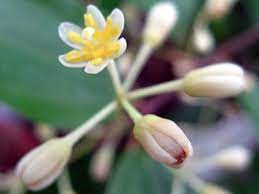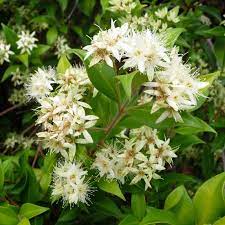Cinnamon flowers refer to the flowers of the cinnamon tree (Cinnamomum verum or Cinnamomum cassia), which are small and inconspicuous. Cinnamon is primarily known for its bark, which is harvested and used as a spice.
The cinnamon tree is an evergreen tree native to Sri Lanka, India, Bangladesh, and Myanmar. The bark of the tree is peeled off and dried, curling into what we commonly know as cinnamon sticks or quills. Cinnamon is widely used for its aromatic and flavorful properties in cooking and baking, and it’s also used for medicinal and aromatic purposes.
However, the flowers of the cinnamon tree are not as well-known or utilized as the bark. Typically, they are small, pale yellow-green in color, and not the main focus of cinnamon production or use. Most culinary and medicinal applications of cinnamon involve the bark rather than the flowers.
The Economic Importance and Uses of Cinnamon Flowers

Cinnamon is a popular spice derived from the bark of trees in the Cinnamomum genus. However, cinnamon flowers are not typically utilized for commercial purposes. The primary economic importance and uses of cinnamon come from its bark and to a lesser extent, its leaves and oil. Here are the economic importance and uses of cinnamon:
1. Spice Production: Cinnamon bark is the most valuable part of the cinnamon tree and is used as a spice. It is harvested, processed, and ground to produce cinnamon powder, sticks, or oil. Cinnamon is a widely used spice in cooking, baking, and flavoring beverages.
2. Culinary Applications: Cinnamon is a versatile spice used in a variety of culinary applications. It adds flavor and aroma to sweet and savory dishes, such as desserts, curries, soups, stews, and beverages like tea and coffee.
3. Medicinal Properties: Cinnamon is known for its potential health benefits. It contains compounds with anti-inflammatory, antioxidant, antifungal, antibacterial, and antiviral properties. It is used in traditional medicine to help with digestion, lower blood sugar levels, improve circulation, and boost the immune system.
4. Pharmaceutical Industry: Cinnamon extracts and essential oil are used in the pharmaceutical industry for various purposes, including in the formulation of medicines, syrups, and herbal supplements. Some compounds in cinnamon are being studied for potential therapeutic applications.
5. Aromatherapy and Fragrance Industry: Cinnamon essential oil is used in aromatherapy and the fragrance industry due to its warm, spicy, and aromatic scent. It is used in candles, perfumes, air fresheners, and other scented products.
6. Food and Beverage Industry: The food and beverage industry uses cinnamon to enhance the flavor and fragrance of a wide range of products, including baked goods, dairy products, confectionery, chewing gum, and beverages.
7. Cosmetics and Personal Care Products: Cinnamon oil and extracts are used in the production of cosmetics and personal care products like lotions, creams, soaps, and perfumes due to their aromatic properties.
8. Traditional and Alternative Medicine: In traditional and alternative medicine practices, cinnamon is used to treat various ailments such as gastrointestinal issues, colds, respiratory problems, menstrual cramps, and joint pain.
9. Flavoring and Condiments: Cinnamon is used as a flavoring agent in a variety of food products, including sauces, marinades, dressings, and condiments. It provides a distinctive and appealing taste to these products.
Read Also: Cinnamon stems: Economic Importance, Uses, and By-Products
10. Export and Trade: Cinnamon is a significant export product for countries where it is cultivated. Countries like Sri Lanka, Indonesia, China, Vietnam, and India are major exporters of cinnamon and derive significant economic value from its export
The Products and By-products That Can Be Derived From Cinnamon Flowers
Cinnamon, primarily known for its aromatic bark, is obtained from the bark of trees belonging to the Cinnamomum genus. While the bark is the main product derived from cinnamon trees, the flowers of the cinnamon tree can also yield certain products and by-products. Here’s a list and explanation of potential products and by-products derived from cinnamon flowers:
1. Cinnamon Flower Oil: Essential oil extracted from cinnamon flowers is a valuable product. It contains aromatic compounds with a distinct aroma, similar to the cinnamon bark oil but with a slightly different composition.
2. Cinnamon Flower Extract: Cinnamon flower extract can be used in cosmetics, skincare products, or in traditional medicine for its potential therapeutic properties.
3. Cinnamon Flower Tea: Cinnamon flower tea is consumed for its potential health benefits, aroma, and flavor.
4. Cinnamon Flower Infused Honey: Cinnamon flower-infused honey can be used as a natural sweetener with added flavor and potential health benefits.
5. Cinnamon Flower Potpourri: Dried cinnamon flowers can be used in potpourri, a mixture of dried, naturally fragrant plant materials. Potpourri is used for its aromatic properties, often placed in bowls or sachets to freshen up living spaces.
6. Cinnamon Flower Soap: Cinnamon flower soap can be used for its aroma and potential skin-soothing properties.
7. Cinnamon Flower Scented Candles: Cinnamon-scented candles are used for aromatherapy, relaxation, and to create a pleasant ambiance.
8. Cinnamon Flower Potentially Edible Parts: Depending on the specific species and parts of the cinnamon flower, some parts may be edible and used in culinary application. flower petals or other edible parts may be used in cooking, garnishing, or as an ingredient in certain traditional dishes.
In conclusion, it is important to note that the production and usage of these products and by-products may vary based on cultural practices, regulations, and availability of cinnamon flowers. Additionally, proper processing and handling of cinnamon flowers are essential to ensure safety and quality in the derived productss.
Read Also: How to Grow Hibiscus Flowers in Your Garden

